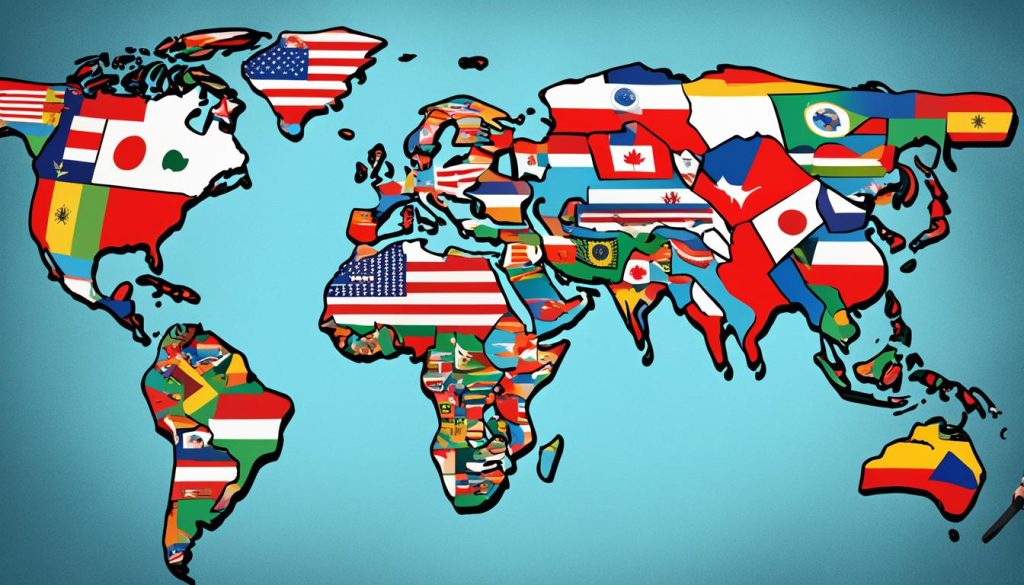In today’s connected world, tailoring marketing to fit local tastes and cultures is key for global brands. By adapting messages to suit the local language, culture, and behaviours, brands can create a stronger connection. This results in building trust, a stronger brand image, and easier growth across borders.
Companies like Coca-Cola have seen big wins with such strategies. Their “Share a Coke” campaign in Australia is a great example. It shows how customised marketing boosts engagement, loyalty, and market share.
Key Takeaways
- Adapting content to local preferences increases consumer engagement.
- Consider cultural nuances to build trust with local audiences.
- Localized content reinforces an authentic brand image.
- Personalized campaigns enhance customer loyalty.
- Regional adaptation facilitates smoother international expansion.
Understanding the Importance of Localising Marketing Efforts
Localising marketing content shows how important culture is in today’s world. By making messages fit local tastes, brands show respect for different cultures. This builds trust and shows brands are serious about connecting with customers.
Why Local Preferences Matter
Being relevant to various cultures is key. Using local traditions and languages in marketing really matters. It makes people feel valued for their cultural identity, boosting loyalty and how they see the brand.
Building Trust with Local Audiences
Location-based messages boost engagement and trust. When content reflects people’s experiences, it strengthens their bond with the brand. Trust is vital for winning over customers in the long term.
Enhancing Brand Authenticity
Geomarketing that considers local preferences shows a brand is authentic. It makes a brand stand out by showing it cares about its audience. This leads to stronger support from consumers, making localized marketing crucial for global success.
Benefits of Tailoring Marketing Campaigns for Local Audiences
Changing marketing to fit local tastes brings lots of positives. By looking closely at market segments and making customers feel special, brands build stronger ties with their audience.
Increased Engagement and Sales
Marketing that matches local likes boosts both attention and profits. Knowing cultural details lets brands talk directly to people’s hearts. This makes folks feel special, leading to more interest and better sales.
Improved Customer Loyalty
Making customers feel unique not only lifts sales but also loyalty. Brands that get their local customers gain lasting followers. If people see a brand values their culture, they stick with it. This connection makes the brand part of the community, keeping customers for a long time.
Overcoming Expansion Hurdles
Getting into new markets can be tough. But, with good strategies in market segmentation and personalising for customers, companies find it easier. By honouring local tastes and knowing what each region likes, brands become welcome faster. Tailoring messages for each place avoids cultural mix-ups and helps with starting up in new areas.
Strategies for Effective Marketing Localization
A smart marketing localisation strategy is crucial for connecting with local people. It includes steps like market research and working with local pros. This makes sure the brand’s message fits with what the area likes.
Conducting Comprehensive Market Research
At the heart of effective marketing localisation lies detailed market research. Knowing the specific wishes of local people helps a lot. This knowledge lets us create messages that really talk to them, making sure they feel seen and heard.
Collaborating with Local Experts
Working with local experts makes a big difference in localisation. These pros know all about the local culture and what people like. Their insights help tailor marketing in a way that feels right to locals.
Leveraging Local SEO
Using local SEO to get noticed is key in marketing localisation. Making content climb in local searches helps reach the right people. By focusing on local likes and keywords, websites attract more visitors. So, smart SEO, based on location and personal touches, builds strong local ties.
Customizes Marketing Messaging and Campaigns to Suit Local Preferences
Customising marketing to fit local tastes means making your brand’s messages and designs reflect the local language, trends, and values. It is vital that your brand feels close to the hearts of the local community. This strategy is more than just translating words. It captures local sayings and unique cultural details.
Using localised content right involves knowing local slang and societal quirks. This makes customers feel special and connected to your brand. Creating personalised campaigns for local holidays and behaviours boosts customer loyalty and engagement.
Understanding cultural relevance is key in marketing. Respect for local traditions, values, and history is essential. Brands that get this right build deep connections with their audience. By focusing on local preferences in your marketing, you create lasting relationships, not just sales.
Challenges in Localising Marketing Collaterals
Localising marketing materials means facing challenges. One must overcome language barriers and ensure accurate cultural fit. Effective translation keeps the brand’s message consistent across different markets. Yet, mistakes in translation can change the intended meaning, leading to misunderstandings or negative views.
Understanding local customs, humour, and what’s sensitive is key to cultural adaptation. If marketing fails to connect with local people, it leads to less engagement or even a negative response. So, putting great effort into localising marketing materials is very important.
Dealing with language barriers is more than direct translation. It’s about capturing the local culture’s spirit. Errors here show why it’s vital to have skilled translators and local experts. They help weave the brand’s message into the local setting smoothly.
Case Studies: Successful Marketing Localization Examples
Exploring successful marketing localization offers valuable insights. It helps brands grow globally. Let’s look at how Airbnb, Coca-Cola, and McDonald’s used localization to improve their market presence.
Airbnb’s Personalised Approach
Airbnb’s personalized marketing highlights its focus on local preferences. It accepts local payments and lists experiences that feel personal. This approach has boosted Airbnb’s appeal worldwide.
Coca-Cola’s “Share a Coke” Campaign
Coca-Cola’s “Share a Coke” campaign brilliantly used marketing localization. Personalising bottles with local names built inclusion and community. It became a worldwide hit, showing how localization can boost sales.
McDonald’s Consistent Global Messaging
McDonald’s achieves a balance between global brand identity and local tastes. It adds regional flavours to its menu. This strategy shows the strength of combining global consistency with local appeal.
Common Mistakes to Avoid in Marketing Localization
Stepping into marketing localisation needs a careful approach. It’s all about connecting well with different regions’ audiences. This means paying close attention to cultural sensitivity, making sure translations are accurate, and understanding what adapts best regionally.
Ignoring Cultural Sensitivities
Ignoring cultural sensitivities can greatly harm your marketing efforts. What’s funny in one culture may upset another. So, it’s vital to research cultures deeply and get advice from local experts. This helps ensure your message fits well with the local culture and traditions, avoiding alienation.
For example, a message that works in the United Kingdom may not fit elsewhere without some changes. Adjustments are necessary to respect local values and traditions. This way, you won’t turn off potential customers.
Literal Translation Errors
Getting translations right is key to keeping your brand’s message clear. But direct translations can mess things up. Take Pepsi’s slogan that ended up meaning “Pepsi brings your ancestors back from the grave” in Chinese as an example. To steer clear from such mistakes, use professional translators and local linguists. They’ll grasp both language subtleties and cultural context.
Neglecting Regional Preferences
It’s also easy to overlook regional preferences. Your marketing should mirror what local markets want and how they behave. What appeals to city dwellers might not click with people in rural areas because their lifestyles and values differ. So, doing deep market research is crucial to tailor your marketing correctly. This respects and meets regional preferences in your marketing plans.
In conclusion, dodging these marketing localisation missteps can really boost your brand’s acceptance and success in various regions. By valuing cultural sensitivity, ensuring translation is spot-on, and adapting to local tastes, your brand can grow globally while respecting local nuances.















